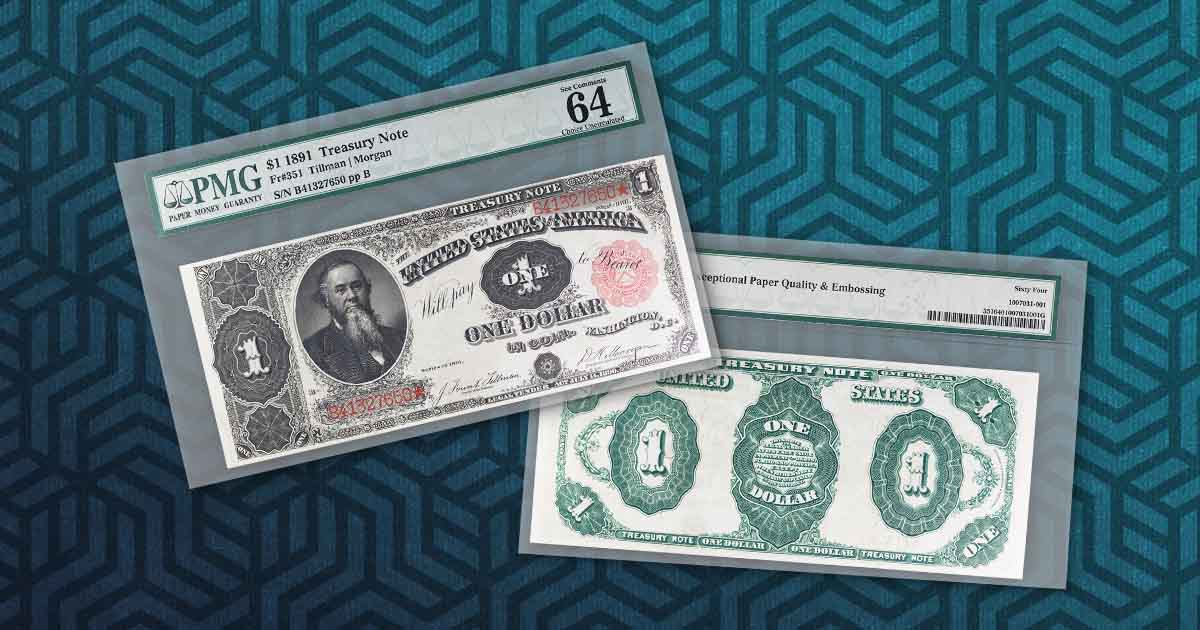
Treasury notes were a representative money issued by the United States between 1890 and 1893.
Why were Treasury Notes Issued?
Treasury Notes were issued under the Sherman Silver Purchase Act, which was enacted on July 14, 1890. The act mandated that the U.S. Treasury buy 4.5 million ounces of silver monthly to mint silver dollars.
This was done to balance the demands made by silver advocates who pushed for the free coinage of silver and gold investors who were concerned about moving away from a gold backed dollar.
Denominations and Design of Treasury Notes
The 1890 issues of Treasury Notes featured elaborate designs on the reverse to prevent counterfeiting. Critics claimed the ornate details would make it harder to distinguish between authentic notes and counterfeit notes. Consequently, the reverses were simplified in the 1891 series, although the portraits on the obverse were identical.
There were treasury notes in denominations between $1 and $1,000. They are considered large size with dimensions of 7.375 by 3.125 inches. The $1,000 Treasury Note was known colloquially as the Grand Watermelon and is considered the best of the U.S. notes by Bowers and Sundman in their 2006 book The 100 Greatest American Currency Notes. Only seven Grand Watermelon notes are known to exist today.
Denominations and Portraits of Treasury Notes
| Denomination | Series | Portrait |
| $1 | 1890, 1891 | Edwin Stanton |
| $2 | 1890, 1891 | James McPherson |
| $5 | 1890, 1891 | George H. Thomas |
| $10 | 1890, 1891 | Philip Sheridan |
| $20 | 1890, 1891 | John Marhsall |
| $50 | 1891 | William Seward |
| $100 | 1890, 1891 | David Farragut |
| $500 | 1891 | William Tecumseh Sherman |
| $1,000 | 1890, 1891 | George Meade |
Factors That Led to the Issuance of Treasury Notes
The End of Bimetallism and the Crime of ‘73
The Coinage Act of 1873 temporarily halted silver dollar production and moved the nation towards a gold standard, which benefited gold investors and creditors. Since the U.S. dollar was, in effect, backed by gold, the dollar faced deflation. To make matters more complicated, the Crime of ’73 had impacted the price of silver and gold. Since silver had been demonetized, silver prices fell, and gold prices rose.
Indebted farmers who had taken out loans or mortgages during more prosperous years had to pay off those debts in a fixed dollar amount. As a result of deflation, the purchasing power of the dollar grew, and while the debts did not grow, earnings in deflated dollars shrunk, making the interest burden more significant.
Silver advocates believed that a silver backed dollar and its inflation would make it easier to repay their debts.
The Bland-Allison Act
The Bland-Allison Act was an effort to return to the bimetallic standard and was a response to the Coinage Act of 1873. Representative Richard P. Bland and Senator William B. Allison proposed that the U.S. Government reinstate silver dollars as legal tender and purchase $2 to $4 million in silver monthly.
While the Bland-Allison Act passed, it was vetoed by President Rutherford B. Hayes, who was then over-ridden by Congress on February 28. 1878. However, many believed the act did not do enough to ease the economic hardships of Americans who were struggling to repay their debts. Indebted Americans wanted more currency added to the system.
The Sherman Silver Purchase Act
A mere 12 years after the Bland-Allison Act, the Sherman Silver Purchase Act was passed. Its goal was to increase the purchase of silver and to add money to the economy.
The act benefited farmers, debtors, and mining companies dealing with a weak silver market. The impact of the Sherman Silver Purchase Act was twofold: It provided a substantial increase in the supply of available money, but it also exacerbated economic tensions.
The Panic of 93
Those tensions came to a head in early 1893 with the Panic of 93.
There had been a poor wheat harvest in 1890, and its effects were only felt years later when the wheat market crashed. In 1893, international economic calamity struck after a failed coup in Buenos Aires. This coup was invested upon by the Americans prompted from encouragement from the Baring Brothers agent bank.
Americans withdrew money from the banks, prompting bank runs. The effects were felt throughout the United States and in Europe. President Grover Cleveland convinced Congress to repeal the Sherman Silver Purchase Act shortly after his inauguration in 1893; but it was too late to stop the short-term recession.
The ramifications of those three factors were felt in the domestic market for four years in one of the most severe economic depressions in U.S. history. The diligent work of the Morgan-Belmont Syndicate helped restore faith in the U.S. dollar, as well as the Specie Payment Resumption Act of 1875, which restored the gold standard.




